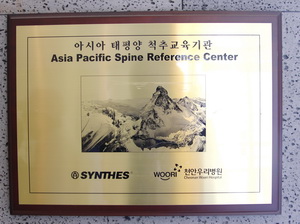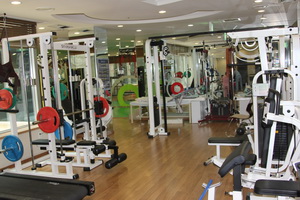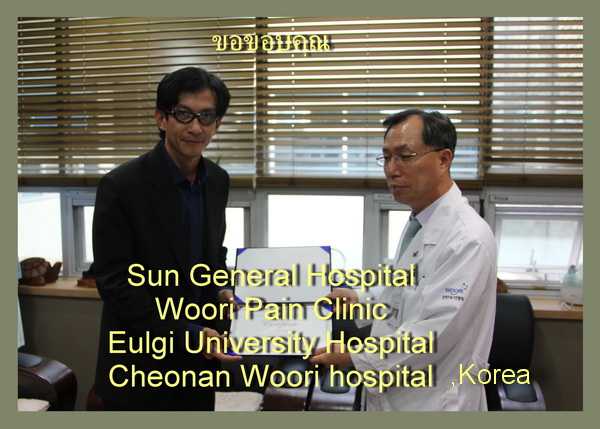
The Percutaneous Epidural Neuroplasty (PEN)
1. The newly designed tool is called PCM (Pain Control Manipulator). The handle is connected to a very small tube of 2 mm diameter and 30 cm lengths at the end of the tube embedding an even smaller tube used for injection. This small tube is gradually inserted into the space at the back of the lumbar on top of the coccyx, and then slides up into the connected epidural space of the spine at the waist up to the area where the scar tissue is.

2. The PCM tube, which is inserted from below, can reach the epidural space of the spine at the waist where the scar tissue is.
rn



3. The method called Mechanical Lysis enables the doctor to trim and shear the scar tissue around the marrow sac. The handle controls the moving, sliding, trimming and shearing which releases the nerve from the compression and contraction tension caused by the scar fibrosis

4. There is a pocket at the handle that can be connected to the syringe. This enables the doctor to give the injection of antibiotics and the fibrosis disruption medicine at the origin of the compression at many spots, both left and right, with one insertion of the tube.rn

Note: The epidural space is the area between your spinal cord and the bones that make up your spine. Pain may be caused by scar fibrosis in the epidural space pressing on nerves in your spine. Epidural adhesiolysis may be used to remove the scar tissue.
The advantages of Percutaneous Epidural Neuroplasty
1. No big cut-open operation scar the scar is smaller than the spinal endoscopic back surgery
2. No need to stitch up the wound because the scale is very small; the size is only about 3-5 millimeter
3. Minimal blood loss the small tube is inserted into the natural existing epidural space of the coccyx bone
4. No need to use anesthetic or back blocking
5. There is no need for the patient to skip from work or stay in the hospital
6. Quick recovery rate after the treatment and spending 3 to 4 hours in the recovery room, you can go back home
The Reason for a Percutaneous Epidural Neuroplasty Operation

Dense epidural fibrosis can cause nerve root irritation, entrapment, compression and restrict nerve root mobility. When encased in scartissue, nerve fibers are subject to increased tension, impaired blood supply and a reduced capacity to transport substances along its length. This causes the patient to have backache and streaking pain on the legs. The symptom can be found in patients with the following diseases:
1. The patient with previous back operation but never had rehabilitation for the muscle and backbone structure system.
2. The patient with herniated invertebral disc or has been suffering from the invertebral bone compression on the nerve root for sometime
3. The elderly patient with degenerative backbone, narrowed spinal canal or chronic inflammation of the back
The Percutaneous Epidural Neuroplasty (PEN) Procedure
1. Refrain from food and water intake at least 6 to 8 hours before the operation
2. The treatment will be done in the sanitation-controlled operation room. The C-Arm x-ray, which is the real time x-ray, will be used. The picture of the target area at the waist will be immediately seen on the monitor without having to wait for the x-ray film
3. The patient lies face down on the operation bed. The patient will remain conscious and can even talk with the doctor during the time of trimming and shearing of the scar fibrosis, and the injection. The treatment will take 5 to 15 minutes depending on how many spots of the symptom origin on the spinal bone at the waist area are treated.

Percutaneous Epineural Neuroplasty
4. Clean the skin with the general operation infection solution
5. Inject local anaesthetic so that the patient will not feel the pain. Insert the 2 mm-diameter tube through the skin. Gradually insert the tube to the target spot, which can be seen from C-Arm X-ray or Bi Plane X ray

6. When the end of the PCM (Pain Control Manipulator) reaches the target i.e. the herniated disc at the number 4 and 5 waist bone (lumbar), the doctor will inject the scar fibrosis disintegration medicine and the antibiotic. The doctor will also control the tube to trim and shear the scar fibrosis from the front of the marrow sac, increased the area of the epidural space

Demonstrative VDO: the PCM is accurately inserted from the back spinal space on the left into the neuron on the right; time span is less than 2 minutes
7. The injection and taking out of the scar fibrosis will take about 1-2 minutes for each vertebrate section. After the treatment, the tube will be pulled out; the skin where the tube was inserted is cleaned and the plaster band is taped on. The patient can now lie on his/her back and rest in the post-operative room for 3-4 hours before discharging from the hospital. The follow-up checkup will be 3-7 days later.

The result of P.E.N technique can be divided into 2 stages :
1. The immediate result– Instantly reduces backache and streaking pain down to the legs. This is the result of the anaesthetic and antibiotic injection right to the source of pain; more effective than other treatments- the scar fibrosis disintegration medicine increases the width of the epidural space
2. The long-term result– Trim, shear and disintegrate the scar fibrosis around the epidural space- Increase the surrounding space of the nerve root- The increased space allows the injected medicine to be thoroughly distributed into the source symptom

P.E.N is appropriate for patients with:
- Chronic Back Pain: when the medication and physical therapy does not work or backache still occurs even after the back operation
- Herniated disc, spondylolisthesis (a condition in which one bone in your back slides forward over the bone below it)
- Sciatica pain from
- nerve root compression by the bone spur
- dense epidural fibrosis
- narrowed, blocked epidural space
- The patient needs to have the operation but age, health and congenital disease make it impossible
- The patient who are suffering from back pain with streaking pain to legs but has a phobia of an operation
Restrictions of this procedure are as follow:
1. Should only be performed by the doctor with expertise
2. Requires C-arm X-ray, which is not available in every hospital
3. The patient must cooperate
4. Can be applied only to the lumbar vertebrate (waist area)
Not to be applied to patients with:
– Septicimia (blood infection)
– Chronic infection- Inflamed wound at the area where the tube will be inserted
– Blood disease
– Serious heart disease
– Patient denying the operation
– Serious depression
Statistical data P.E.N
P.E.N is widely used by every hospital in Korea, especially Cheonan Woori Hospital that specializes in vertebrate diseases. In 2011, there were 847 out of 2000 patients treated with P.E.N. The recovery rate with no recurring pain is more than 90% while the rate of retreatment within one year is just 1%. Meanwhile, 4% is with no response and will need to go through the operation. (Thanks to Cheonan Woori Hospital for the data provided)






Above all, when you recover from the backache with streaking pain to your legs, you need to exercise the muscle structure of the vertebrate system to be healthy and in balance with day-to-day life, especially the exercise of the Core Muscle in the middle of the body. The exercise is based on a specific concept and procedure, which will give great results for the back muscle and vertebrate.
Even P.E.N procedure is low risk, high safety but if the pain is not corrected from the original cause, the chances of getting cured is reduced. The absolute treatment can be achieved only if P.E.N patients take the inner back muscle exercise correctly. The exercises should be practiced consistently at home.



